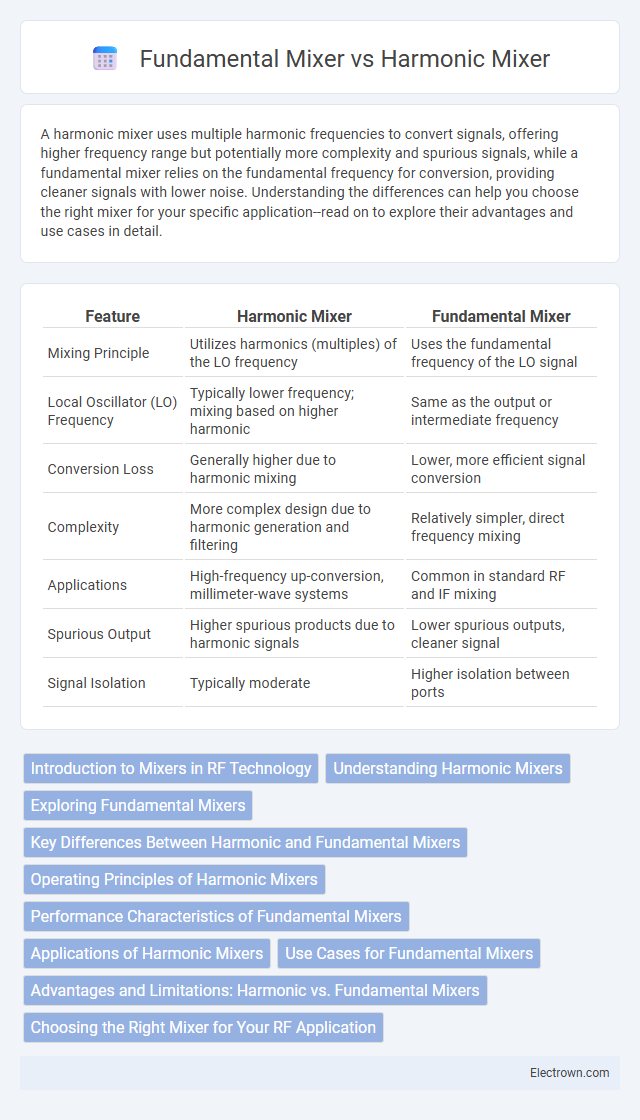A harmonic mixer uses multiple harmonic frequencies to convert signals, offering higher frequency range but potentially more complexity and spurious signals, while a fundamental mixer relies on the fundamental frequency for conversion, providing cleaner signals with lower noise. Understanding the differences can help you choose the right mixer for your specific application--read on to explore their advantages and use cases in detail.
Table of Comparison
| Feature | Harmonic Mixer | Fundamental Mixer |
|---|---|---|
| Mixing Principle | Utilizes harmonics (multiples) of the LO frequency | Uses the fundamental frequency of the LO signal |
| Local Oscillator (LO) Frequency | Typically lower frequency; mixing based on higher harmonic | Same as the output or intermediate frequency |
| Conversion Loss | Generally higher due to harmonic mixing | Lower, more efficient signal conversion |
| Complexity | More complex design due to harmonic generation and filtering | Relatively simpler, direct frequency mixing |
| Applications | High-frequency up-conversion, millimeter-wave systems | Common in standard RF and IF mixing |
| Spurious Output | Higher spurious products due to harmonic signals | Lower spurious outputs, cleaner signal |
| Signal Isolation | Typically moderate | Higher isolation between ports |
Introduction to Mixers in RF Technology
Mixers in RF technology are crucial components that convert signals from one frequency to another, enabling effective modulation and demodulation in communication systems. Harmonic mixers utilize higher-order harmonics of the local oscillator to achieve frequency conversion, offering advantages in frequency range and flexibility. Fundamental mixers operate using the fundamental frequency of the local oscillator, providing better linearity and lower noise, which are essential in high-sensitivity applications.
Understanding Harmonic Mixers
Harmonic mixers utilize nonlinear diodes to generate and mix multiple harmonics of the local oscillator frequency, enabling signal frequency conversion beyond the fundamental frequency. These mixers are essential in applications requiring wide frequency range upconversion or downconversion, such as millimeter-wave and microwave systems. Their ability to efficiently produce higher-order mixing products distinguishes them from fundamental mixers that operate strictly at the fundamental local oscillator frequency.
Exploring Fundamental Mixers
Fundamental mixers use a non-linear device to generate output signals at the sum and difference of input frequencies, maintaining high spectral purity and lower spurious content compared to harmonic mixers. These mixers are ideal for applications requiring precise frequency conversion with minimal signal distortion, such as radar and communication systems. Your choice of a fundamental mixer ensures better signal integrity when accurate frequency translation is crucial.
Key Differences Between Harmonic and Fundamental Mixers
Harmonic mixers use nonlinear devices to generate output signals at multiples of the input frequencies, enabling frequency conversion beyond the fundamental frequency. Fundamental mixers operate primarily on the first-order (fundamental) mixing product, offering better signal purity with lower harmonics and spurious outputs. Your choice depends on whether you prioritize frequency range extension and flexibility with harmonic mixers or cleaner signals and improved linearity with fundamental mixers.
Operating Principles of Harmonic Mixers
Harmonic mixers operate by utilizing nonlinear elements to generate multiple frequency harmonics from the input signal, mixing these harmonics with the local oscillator to produce the desired intermediate frequency. Unlike fundamental mixers that only use the fundamental frequencies of the signals, harmonic mixers exploit higher-order harmonics, enabling frequency conversion at multiples of the local oscillator frequency. This principle allows harmonic mixers to be effective in applications requiring high-frequency operation beyond the local oscillator's fundamental range.
Performance Characteristics of Fundamental Mixers
Fundamental mixers exhibit superior linearity and lower intermodulation distortion compared to harmonic mixers, making them ideal for applications requiring clean signal conversion. They operate by mixing signals at the fundamental frequency, ensuring accurate frequency translation with minimal spurious outputs. Their performance is highly dependent on the quality of the local oscillator and mixer diode characteristics, resulting in consistent conversion gain and noise figure.
Applications of Harmonic Mixers
Harmonic mixers are widely used in frequency multiplication and sub-harmonic signal generation for radar systems and communication receivers. Their ability to convert high-frequency signals using harmonics makes them ideal for applications requiring wideband frequency translation with minimal local oscillator leakage. You will find harmonic mixers essential in millimeter-wave instrumentation, signal analysis, and testing environments where precise harmonic mixing improves performance.
Use Cases for Fundamental Mixers
Fundamental mixers are widely used in communication systems for frequency conversion in transmitters and receivers due to their linearity and low noise characteristics. They excel in applications requiring precise signal processing, such as narrowband communications, radar systems, and signal modulation, where maintaining signal integrity is critical. Fundamental mixers typically handle lower input power levels effectively, making them ideal for sensitive RF front-end circuitry in wireless communication devices.
Advantages and Limitations: Harmonic vs. Fundamental Mixers
Harmonic mixers offer the advantage of frequency multiplication, allowing them to generate output signals at harmonics of the input frequency, which is beneficial for wideband frequency conversion and measuring high-frequency signals with low local oscillator frequencies. However, they typically exhibit higher conversion loss and spurious responses compared to fundamental mixers, which operate only at the fundamental frequency and provide better linearity and lower intermodulation distortion. Fundamental mixers are preferred for applications demanding high signal purity and low noise but are limited in frequency range, making harmonic mixers more suitable for ultra-high-frequency applications despite their complexity and potential signal degradation.
Choosing the Right Mixer for Your RF Application
Fundamental mixers directly convert RF signals to intermediate frequencies with low spurious outputs, making them ideal for applications requiring high linearity and low noise. Harmonic mixers utilize higher-order harmonics of the LO signal, enabling frequency multiplication and simpler LO generation but often introduce additional spurious responses. Your choice depends on the trade-off between spectral purity, conversion efficiency, and the complexity of the local oscillator circuit in your RF application.
Harmonic Mixer vs Fundamental Mixer Infographic

 electrown.com
electrown.com